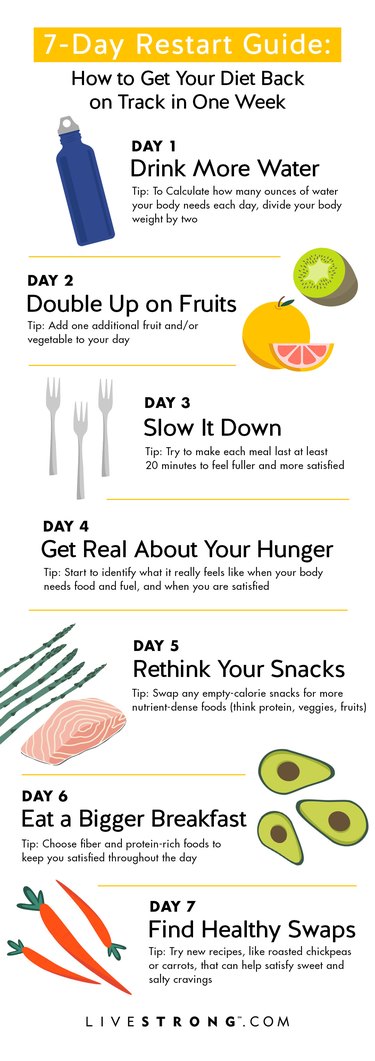
You researched for hours to find the healthiest — and most delish — recipes. You filled up your virtual shopping cart and scheduled delivery. You stocked your fridge with sparkling waters, just in case your sugar cravings hit hard. And then… you slipped off the bandwagon. The veggies went bad — and your hankering for french fries won over your voice of reason.
First and foremost, don't beat yourself up. We've all been there. Secondly, keep things in perspective: With just a few small tweaks, you can get your healthy eating back on track and your goals back in sight.
Video of the Day
Video of the Day
Where to start? Rather than go too far in the other direction, set up a small daily goal for seven consecutive days, suggests Anne L'Heureux, RD, LD, registered dietitian for Spartan.
That's long enough to start forming new, healthy habits again and to give yourself small opportunities to feel a sense of pride and accomplishment. "It's often those feelings — not the actions themselves — that keep people focused," she says.
Ready to get your diet back on the right track? Here's your one-week plan.
Day 1: Drink More Water
If you woke up feeling exhausted, you may be tempted to reach for a sugary, caffeinated beverage. But fatigue can be a symptom of dehydration, L'Heureux explains, so make your day-one goal an easy one: Drink some good old-fashioned H2O.
In fact, every time you get the urge to stop by your local cafe or visit the lunchroom vending machine, try sipping on water or seltzer instead.
The benefit here is threefold: "You will help keep the body hydrated, decrease feelings of fatigue and save on unnecessary calories," L'Heureux explains.
Tip
How much water are we talking? Divide your body weight by two for the number of ounces you should consume every day, L’Heureux says.
If that seems daunting, remember that you can also reap hydration from water-heavy fruits and veggies, including:
- Bok choy
- Celery
- Cucumber
- Oranges
- Radishes
- Tomatoes
- Watercress
- Watermelon
- Zucchini
Day 2: Double Up on Fruits and Veggies
When you're attempting to make smarter, more fruitful dietary choices, it can all feel a little overwhelming. L'Heureux says many people get caught up in the nitty-gritty of what they can't eat, instead of focusing on the creative ways they can improve their diet.
When you do the former, she notes, you're more likely to get tired of repetitive dishes — and more likely to give into your cravings.
To combat this, your goal for day two is an easy one: Double up on your intake of nature's candy.
"Start simply by adding one additional fruit and vegetable option into your day," L'Heureux says, offering the following easy tips:
- Upgrade that simple bowl of cereal by topping it with blueberries.
- Already putting fruit in your smoothie? Add a handful of spinach, too.
- Looking for a snack to tide you over until dinner? Baby carrots are refreshing and sweet.
Related Reading
Day 3: Slow It Down
On day three, try pumping the brakes when it comes to mealtime, suggests Samantha Cassetty, RD, dietitian and director of nutrition for The Healthy Mommy, which offers weight-loss plans for moms.
Here's the deal: When you're overly distracted while you're eating (or taking your meal on-the-go, like many of us), it's more difficult to feel fully satisfied with what you're eating.
"You'll get more enjoyment out of meals and possibly feel fuller longer if you slow down while you eat," she says. "Since it takes your brain 20 minutes to arrive at the table, make sure your meal lasts at least that long."
If you find yourself zipping through a nosh session, Cassetty suggests trying the following:
- Put down your utensils between bites.
- Mentally describe what your food tastes like, using adjectives like savory, crunchy and silky.
- Sit down at the table while you eat and avoid electronics that take your focus away from your food.
- Take smaller bites and chew thoroughly; don't pop in the next mouthful until you've finished the one before.

Day 4: Get Real About Your Hunger
Or in other words: Assess how hungry and full you really are.
To keep your diet on track for all seven days — and long after — Cassetty says it's essential to learn how to listen to your body and think critically about whether or not it needs food.
"We're born to do this, but we learn to override these signals," she explains. "Start to identify what it feels like to be hungry so you can respond appropriately, and also begin to notice what it feels like when you're satisfied."
When you get really in tune with these cues, she says, you might find that you don't need to finish everything on your plate (bonus: leftovers!).
Day 5: Rethink Your Snacks
Not-so-surprising fact: Cassetty says the vast majority of Americans snack several times throughout the day, yet they aren't meeting their fruit and veggie targets.
By definition, this in-between nibble is meant to tide you over between meals — but it shouldn't be void of all nutrition (looking at you, caramel latte).
So, your day-five challenge? Swap any empty-calorie snacks for those that are more nutrient-dense (think: protein, veggies, fruits). This means you'll have to bid adieu to your favorite packaged bars or chips and be a little more mindful about what you're putting in your mouth.
Not only will you likely be cutting out calories, but you could see an uptick in your mood, too. Increased produce portions were linked with higher levels of happiness and life satisfaction in a study published August 2016 in the American Journal of Public Health.
"Try pairing your produce with some protein or lean fat, both of which add flavor and help you stay fuller longer," recommends Cassetty, offering the following ideas:
- A banana with pumpkin seeds or walnuts
- Berries with yogurt
- Carrots with guacamole
Related Reading
Day 6: Eat a Bigger Breakfast
You're inching your way closer to one full week of healthy eating, and you may be starting to feel more energized. Today, put the focus on your first meal.
Many people make poor choices with breakfast, Cassetty says, either by reaching for carb-heavy choices like a muffin or bagel or skipping it altogether — both of which are unhealthy.
The problem with muffins? They don't have the staying power of fiber or protein to keep you satisfied throughout the day, causing you to be distracted by hunger, or even feel cranky, tired or irritable. On the other hand, a balanced brekkie can help set a positive tone for the rest of your day.
"This will help give your metabolism a slight boost and also ensure your meal satisfies you for a while," she says.
Recipes to Try
Day 7: Find Healthy Swaps
With nearly a week under your belt of building healthy eating habits, turn your attention to prolonging these habits by finding healthy swaps you actually enjoy. And remember that they don't have to be huge changes since, as Cassetty notes, a few small tweaks can go a long way.
To get you started, she suggests spending the day testing new recipes that could fulfill your salty cravings, your need to munch or that sweet tooth.
- The craving: Chips
- The healthy swap: Roasted Chickpeas
- The craving: Fries
- The healthy swap: Spiced Butternut Squash Fries
- The craving: Pizza
- The healthy swap: Pizza with cauliflower or zucchini crust
- The craving: Ice cream
- The healthy swap: Cocoa Mint Soft Serve 'Nice' Cream
"The idea isn't about restricting yourself or eliminating pleasures from your life," Cassetty says. "It's about discovering healthier foods and recipes that can be just as delicious and satisfying."

Was this article helpful?
150 Characters Max
0/150
Thank you for sharing!
Thank you for your feedback!